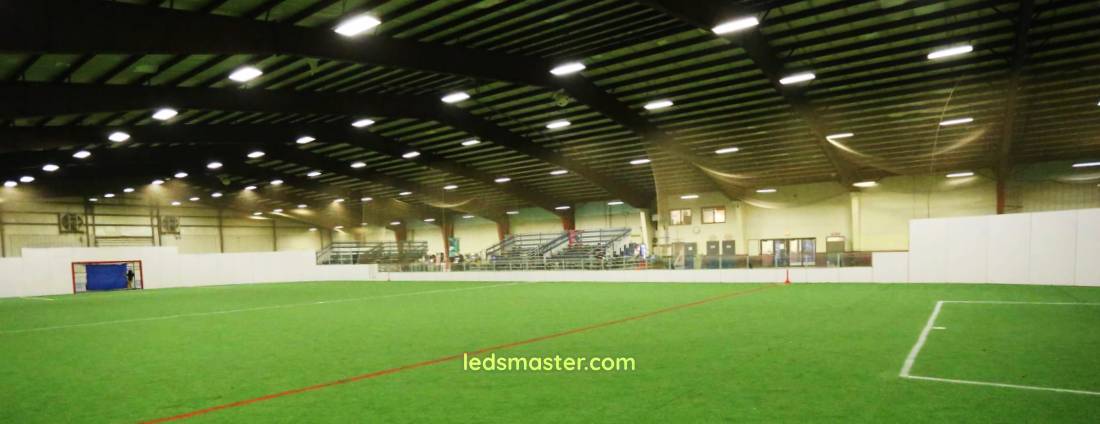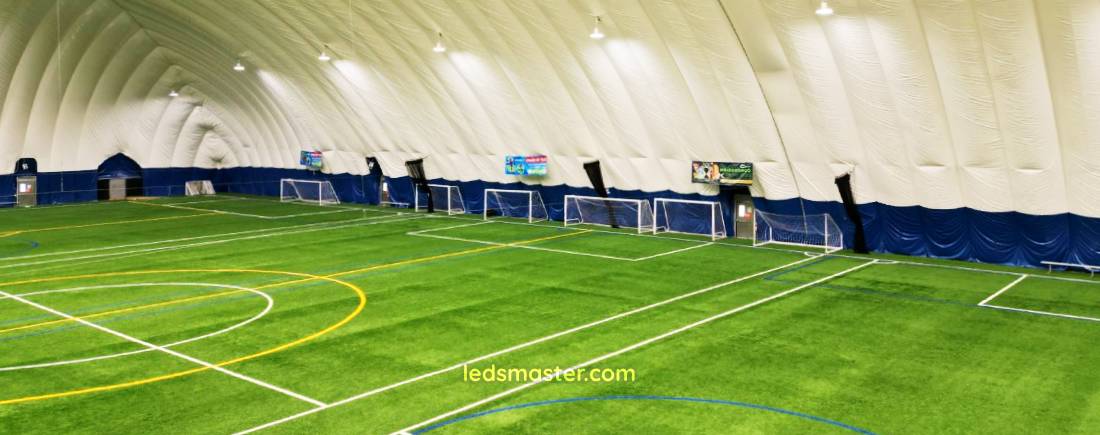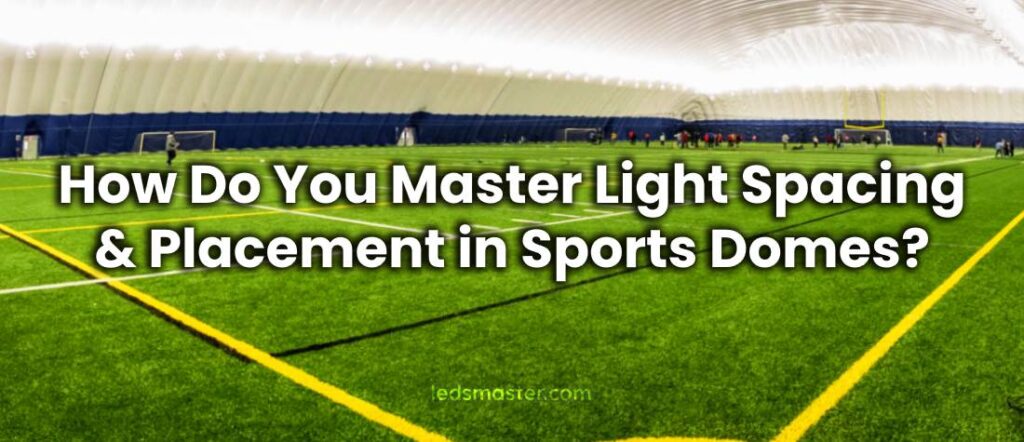Sports domes are large, expansive venues that require a thoughtful approach to lighting. Achieving optimal light distribution across the entire field of play while managing energy efficiency and cost-effectiveness can be a complex challenge. The design of lighting systems in these facilities goes beyond merely illuminating the space; it involves considering factors like light intensity, coverage, and placement. Proper lighting ensures safety, enhances visibility, and maintains the aesthetic value of the space. Getting the lighting right requires a deep understanding of the required number of lights, the spacing between them, and the costs involved in their installation.
Table of Contents
ToggleNumber of Lights Needed for Effective Illumination

When planning lighting for a sports dome, one of the first steps is determining how many lights are required to provide adequate illumination. The number of lights needed depends on several factors, including the dome’s size, ceiling height, the type of sports played, and the level of competition. Indoor sports such as soccer, basketball, and tennis have different lighting requirements, with high-performance or professional-level events demanding greater brightness for optimal visibility and player performance.
| Sports Dome Type | Size (sq. ft.) | Ceiling Height (ft.) | Recommended Lux Level | Estimated Number of LED Fixtures |
|---|---|---|---|---|
| Tennis Dome | 10,000 | 20–30 | 300–600 lux | 40–60 |
| Basketball Dome | 20,000–30,000 | 30–40 | 500–1,000 lux | 80–120 |
| Soccer Dome | 50,000+ | 40–60 | 750–1,200 lux | 200–300 |
Facility Size and Light Requirements
The primary consideration is the total square footage of the facility. A 10,000-square-foot tennis dome may require 40–60 LED fixtures to ensure even lighting across the playing area. In contrast, a mid-sized basketball dome of 20,000–30,000 square feet could need 80–120 fixtures to meet regulation standards. Larger sports domes, such as those used for soccer (50,000+ square feet), typically require 200–300 high-output LED lights to maintain consistent illumination across the entire field. The larger the area, the more lights are needed to prevent dark spots and ensure uniform brightness.
Impact of Ceiling Height on Lighting
Ceiling height also plays a crucial role in determining the number of lights required. Higher domes, ranging from 40 to 60 feet, present additional challenges, as light must be distributed effectively over a large area. In such cases, fixtures may need to be installed closer together or use higher-wattage bulbs to maintain sufficient brightness at ground level. In contrast, domes with lower ceilings (20–30 feet) may require fewer fixtures, though precise positioning remains essential for consistent coverage.
Lighting Technology and Efficiency
The type of lighting technology used also impacts the number of fixtures needed. LED lights are the preferred choice due to their superior efficiency and higher lumen output compared to traditional incandescent or halogen bulbs. A modern LED system typically requires 30–40% fewer fixtures than older lighting technologies while delivering the same or greater brightness. This means that while a traditional metal halide system might require 250 fixtures for a large dome, an equivalent LED system could achieve the same illumination with only 150–175 fixtures, significantly reducing energy consumption and maintenance costs.
By carefully considering these factors—dome size, ceiling height, and lighting technology—sports facility planners can determine the optimal number of lights needed to ensure high-quality illumination that enhances both player performance and spectator experience.
Light Output and Coverage
Light output, measured in lumens, is a key consideration when determining the number of lights needed. The standard for most indoor sports is measured in lux, which describes the intensity of light hitting a given area. For example, a professional basketball court might require anywhere from 500 to 1,000 lux depending on the desired level of play and broadcasting needs. A soccer field, particularly for night games, may need a higher lux level to ensure visibility, with values of 750 lux to 1,200 lux being common.
To meet these requirements, lighting designers must calculate how many lumens each fixture will provide and match it with the total area that needs to be illuminated. This calculation helps avoid areas that are too dark or too bright, which can hinder the experience for both athletes and spectators.
Spacing and Distance Between Lights
Once the number of lights required is determined, the next step is deciding on the spacing and distance between each fixture. Improper spacing can lead to uneven light distribution, creating shadows or overly bright spots, both of which could compromise the integrity of the sports experience.
Placement of Fixtures for Uniform Coverage
Proper light placement ensures that the light is evenly distributed across the entire playing surface. When fixtures are spaced too far apart, certain areas may experience low light levels, which can affect visibility, especially during fast-paced sports. To prevent this, lights should be spaced at intervals that allow them to overlap slightly. This ensures that light intensity is maintained across the entire playing field.
The general recommendation for light spacing in sports domes is that the distance between fixtures should be roughly 1.5 to 2.5 times the mounting height of the light. For example, if the lights are mounted 20 feet above the playing surface, the fixtures should ideally be spaced 30 to 50 feet apart. This ensures the light reaches the entire playing area and reduces the occurrence of dark patches or glare.
Another important aspect to consider is the beam angle of the lights. The beam angle determines how the light is distributed in the space, and it can vary depending on the type of fixture used. A narrower beam angle will focus light more narrowly on a specific area, while a wider beam angle will distribute light over a larger area. A balance must be struck to avoid both areas of excessive brightness and zones that remain under-illuminated.
Adjusting for Dome Size and Shape
The size and shape of the dome play a role in determining the optimal spacing between lights. A large dome with a more oval or irregular shape might require a more customized lighting design to ensure consistent light coverage. In some cases, designers might opt for a combination of general illumination and task lighting, where certain areas, like the playing surface itself, receive a higher level of illumination than others.
The Influence of Dome Height
Dome height is another factor that affects light spacing and distribution. In taller domes, fixtures may need to be spaced further apart to achieve the same level of coverage, as light has a longer distance to travel before it reaches the playing surface. In contrast, lower domes allow for closer fixture placement and more concentrated lighting, which can reduce the overall number of lights required.

Cost of Installation and Maintenance
| Cost Component | Halogen/Fluorescent Lights | LED Lights |
|---|---|---|
| Initial Fixture Cost | $50 to $150 per fixture | $150 to $500 per fixture |
| Total Fixture Cost (100 Lights) | $5,000 to $15,000 (for smaller domes) | $15,000 to $50,000 (for larger domes) |
| Installation Complexity Cost | Basic installation, fewer rigging costs | More extensive installation due to height and smart controls, $10,000 to $30,000 |
| Energy Consumption | Higher power usage, 300W per fixture | Lower power usage, 100W per fixture |
| Average Monthly Electricity Cost | $3,000 (for a medium-sized dome) | $1,500 (for the same dome with LED lights) |
| Annual Energy Savings | – | Up to 50% reduction in energy costs |
| Maintenance Costs (Annual) | $5,000 to $15,000 due to bulb replacements | $2,000 to $5,000 due to longer lifespan of LEDs |
| Bulb Replacement Frequency | Every 1,000 to 2,000 hours (1-2 years) | Every 25,000 to 50,000 hours (10-20 years) |
| Total Maintenance Savings (10 Years) | – | Up to 60% lower maintenance costs over 10 years |
| Smart Lighting System (Optional) | Not common | $10,000 to $20,000 (optional for energy optimization) |
| Total Cost of Ownership (10 years) | $200,000 for traditional lights (including installation and maintenance) | $120,000 for LED lights (including installation and reduced operating costs) |
| Environmental Impact | Higher carbon footprint due to energy consumption | Lower carbon footprint due to energy-efficient LED technology |
Lighting a sports dome involves both technical planning and financial commitment. The overall cost of installation can vary significantly based on factors like the lighting technology chosen, the dome’s size, and the complexity of installation. Understanding these costs helps ensure that decisions are made based on both current needs and long-term sustainability.
Initial Installation Costs
The cost of installing lights in a sports dome includes both the purchase of the lighting fixtures and the labor and materials necessary for installation. The size of the facility and the type of lights chosen will significantly influence these costs. LED lighting systems, although more expensive initially, are known for their energy efficiency and longer lifespan. The upfront cost of installing LED fixtures can range from $150 to $500 per light fixture depending on the wattage and brand. In comparison, halogen or fluorescent lights typically cost between $50 and $150 per fixture, but they come with higher energy consumption and more frequent maintenance costs.
In a sports dome, which may require anywhere from 30 to 150 fixtures depending on its size, this difference can add up quickly. For example, if you choose to install 100 LED lights at an average cost of $300 per fixture, the total for the lights alone would be approximately $30,000. However, choosing fluorescent or halogen lights could lower the initial investment to $5,000 or $15,000, respectively.
Additionally, the complexity of installation can add to the costs. Large domes with high ceilings may require specialized equipment, such as scaffolding or cranes, for light installation, which increases labor costs. For a sports dome with a high ceiling, rigging and safety measures might cost anywhere from $10,000 to $30,000, depending on the size and complexity of the setup.
Furthermore, the design of the lighting system—particularly the inclusion of dimming systems, motion sensors, or smart controls—can increase the overall installation cost. The addition of a smart lighting control system could add another $5,000 to $15,000, depending on the sophistication of the system.
Long-Term Operating Costs
Once the lighting is installed, the long-term operating costs become a crucial consideration. The energy consumption of the lights directly impacts utility bills. LED lights, as an energy-efficient option, consume less power compared to older technologies like halogen or fluorescent lights. For example, an LED light fixture that consumes 100 watts of power will typically produce as much light as a halogen bulb consuming 300 watts. This reduction in energy consumption can lead to energy savings of up to 70% over time.
For a sports dome, the average monthly electricity cost for running the lighting system can range from $1,500 to $5,000 depending on the size of the facility, the number of hours the lights are in use, and the type of lights. LED lights, with their lower energy consumption, can reduce these monthly costs by as much as 50%. For example, if the monthly electricity bill is $3,000 for halogen lights, switching to LED lighting could bring that cost down to $1,500.
Maintenance is another ongoing cost. Traditional lighting systems, like halogen or fluorescent, require frequent bulb replacements, which can be costly and time-consuming. Halogen lights, for instance, may need to be replaced every 1,000 to 2,000 hours of use, and the cost of replacement bulbs can range from $10 to $50 each. In contrast, LED bulbs have a lifespan of 25,000 to 50,000 hours, significantly reducing the frequency of replacements. The maintenance costs for LED systems are typically 60% to 70% lower over the life of the fixtures compared to halogen or fluorescent systems.
Maintenance costs for a typical sports dome could range from $5,000 to $15,000 per year, depending on the type of lights used, the number of fixtures, and the level of service required. With LEDs, these costs could be reduced to as low as $2,000 to $5,000 annually due to their longer lifespan and reduced maintenance needs.
Energy Efficiency and Sustainability
Many sports domes are now prioritizing energy efficiency not only to reduce operational costs but also to lower their environmental impact. The adoption of LED lighting systems is part of a larger trend toward sustainability in sports facilities. LED lights use significantly less energy while providing better illumination, which is a driving force for facilities aiming to lower their carbon footprint.
In addition to switching to LED lights, some sports domes are incorporating smart lighting solutions, which can further optimize energy consumption. These systems automatically adjust lighting levels based on ambient light or occupancy. For instance, lights can be dimmed during off-peak hours or when fewer people are present in the facility, and increased during intense activities or games. Such systems can reduce energy consumption by up to 30%, depending on the usage patterns.
The cost of installing smart lighting systems typically ranges from $10,000 to $20,000, depending on the complexity of the system and the size of the facility. While this adds an initial investment, the energy savings in the long term can offset these costs, with some facilities seeing a return on investment in as little as 3 to 5 years.
Total Cost of Ownership
When assessing the cost of lighting installation and maintenance, it is important to consider the total cost of ownership (TCO) over the life of the system. TCO includes both initial installation costs and ongoing operating expenses, such as energy usage, maintenance, and replacement costs. While the initial installation of LED lights can be more expensive, the lower operating costs and reduced maintenance needs make them a more cost-effective solution in the long term.
Over a 10-year period, the TCO of LED lights is typically 30% to 50% lower than traditional lighting systems. For example, if the total cost of installing and maintaining a traditional halogen lighting system in a sports dome over 10 years is $200,000, switching to LED lights could reduce that figure to around $120,000, thanks to energy savings, lower maintenance costs, and fewer bulb replacements.
In terms of overall savings, sports dome owners could save tens of thousands of dollars over the lifespan of the lighting system by opting for energy-efficient LED fixtures. Moreover, these savings are compounded when factoring in the environmental benefits of reducing energy consumption, as facilities can make a positive impact on their sustainability goals.
Conclusion
Mastering light spacing and placement in sports domes requires a blend of technical expertise, an understanding of the specific needs of the facility, and careful consideration of both immediate and long-term costs. By determining the number of lights needed, optimizing their placement, and factoring in installation and maintenance costs, sports dome managers can create a lighting system that enhances the sports experience, maximizes energy efficiency, and ensures safety. The right approach to lighting can elevate the overall quality of the dome while delivering practical and financial advantages over its lifespan.

